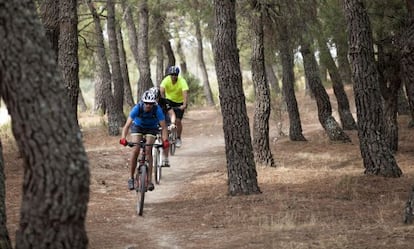Mountain biker’s death highlights dangers of Spain’s cycle-path traps
Forty-three-year old killed in July after riding into cable strung across Cantabria bike route

Jesús Ángel Santos, a 43-year-old cycling enthusiast, was killed on July 25 after he rode into a cable that had been strung at hip height across a specially marked cycle route in Arenillas de Ebro, a small community in the northern region of Cantabria.
Two men are now being investigated for involuntary manslaughter in the first case in Spain involving the deliberate setting of traps for cyclists and motorcyclists in rural areas. But cyclists’ associations say that more and more of their members are reporting such incidents, and mainly blame farmers and hunters unwilling to share the countryside with them.
It was just a matter of time before a tragedy like this happened”
Cyclists have reported barbed wire strung across paths, along with rocks, holes dug, and even wooden boards with nails hammered into them placed on routes in Galicia, Madrid, Asturias, Cantabria, the Basque Country and Andalusia. Dozens of people have been injured.
Locals living close to where Jesús Ángel Santos died refuse to talk about “traps.” Farmers in the area who use electrified fencing to keep cattle and sheep enclosed in temporary pastures normally tie plastic bags to cables as a warning. But in this particular case, the wire was placed across a path just after a tight corner and a sharp descent of around 100 meters. “It’s a tragedy, and very sad. But I don’t see this as somebody setting out to hurt somebody else,” says Raúl Guillarón, secretary general of ASAJA, Spain’s young farmers’ association.
But Victor Tarodo of the International Mountain Bike Association says that in many cases it is clear that obstacles are deliberately placed along rural cycle paths with the intention of causing injury. “It was just a matter of time before a tragedy like this happened,” he says.
Cyclists have reported barbed wire strung across paths, along with rocks, holes and even wooden boards with nails hammered into them on bike routes
“There are always traps in the hills and woods, because these are areas where there is a clash of interests,” says Juan Torrado, president of Asciga, a cycling association in Galicia. “We are up against landowners, farmers, hunters, and even pyromaniacs trying to cover their tracks… Some think we frighten away the prey, while others complain because there is the odd cyclists who, without permission, opens up a new route,” he says, adding that mountain bikers now tell the Civil Guard when they find an obstacle, “but unless somebody has been hurt, they don’t look for those responsible.”
The Civil Guard says officers belonging to its Seprona environmental protection unit are targeted as well, and that poachers often lay traps to puncture the tires of their motorbikes so they cannot be pursued.
Some of the most serious incidents have taken place in Galicia. In 2014, 37-year-old Diego González was left paralyzed after his bike hit a large rock placed across the path he was traveling down in a rural area close to the port city of Vigo. Four local men are under investigation, but a trial date has yet to be set.
Following the incident, the regional government has organized meetings between different rural stakeholders to lay out a code of practice. “Nobody in particular is to blame; some people will do terrible things, but there are good and bad people among all the groups interested in using rural areas: cyclists, hunters and farmers. The idea is to pursue wrongdoers and reach agreement on using this natural space,” says Torrado.
Spain’s Royal Hunting Federation condemns the laying of traps for cyclists, and calls for local governments to clearly indicate authorized routes that cross private land. Juan Jose Trueba, president of the cycling federation of Cantabria, has called on cyclists to photograph routes where there are conflicts of interest. “We have already received several photos, most of them of electrified fencing placed across paths,” he says.
Cyclists’ associations say that in areas where there are clearly indicated cycle routes, local authorities should prevent animals from straying by installing cattle grids or large metal gates that are easily visible.
Tu suscripción se está usando en otro dispositivo
¿Quieres añadir otro usuario a tu suscripción?
Si continúas leyendo en este dispositivo, no se podrá leer en el otro.
FlechaTu suscripción se está usando en otro dispositivo y solo puedes acceder a EL PAÍS desde un dispositivo a la vez.
Si quieres compartir tu cuenta, cambia tu suscripción a la modalidad Premium, así podrás añadir otro usuario. Cada uno accederá con su propia cuenta de email, lo que os permitirá personalizar vuestra experiencia en EL PAÍS.
¿Tienes una suscripción de empresa? Accede aquí para contratar más cuentas.
En el caso de no saber quién está usando tu cuenta, te recomendamos cambiar tu contraseña aquí.
Si decides continuar compartiendo tu cuenta, este mensaje se mostrará en tu dispositivo y en el de la otra persona que está usando tu cuenta de forma indefinida, afectando a tu experiencia de lectura. Puedes consultar aquí los términos y condiciones de la suscripción digital.








































